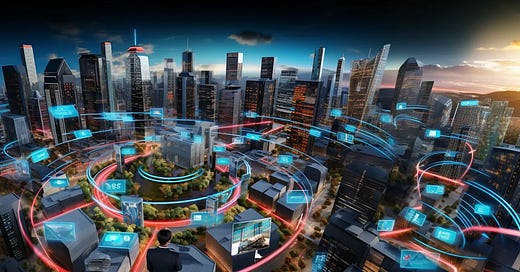XR with 5G (S01/E34)
The integration of 5G technology with Extended Reality (XR) is a groundbreaking development in the tech world, heralding a new era of digital experiences. This powerful combination promises to revolut
The integration of 5G technology with Extended Reality (XR) is heralding a new era in digital interaction and immersive experiences. This synergy is enhancing current applications and unlocking new possibilities in virtual, augmented, and mixed realities. In this exploration, we delve into the revolutionary impact of 5G on XR, highlighting its advantages, potential drawbacks, and focusing on the exciting use cases and companies leading the way in this domain.
The 5G Revolution in XR
5G, the latest advancement in broadband cellular networks, is characterized by its exceptional speed, reduced latency, and increased capacity. These features are especially beneficial in the realm of XR.
Enhanced Speed and Reduced Latency
The ultra-fast data transfer speed of 5G is transformative for XR, enabling smoother, more realistic, and immersive experiences in VR and AR. High-fidelity graphics and complex simulations, previously limited by slower networks, can now be seamlessly integrated.
The low latency of 5G is critical for real-time interactions in XR, ensuring that virtual environments respond almost instantaneously to user actions, which is essential for maintaining immersion and preventing motion sickness in VR.
Increased Capacity and Connectivity
5G networks support a higher number of connected devices simultaneously without compromising performance, vital for collaborative XR experiences in shared virtual spaces.
Exciting Use Cases and Leading Companies
1. Telemedicine and Remote Surger*: Companies like Proximie are utilizing 5G-enabled XR for remote medical training and surgical procedures, offering real-time collaboration between surgeons across different locations.
2. Immersive Learning and Training: Microsoft's HoloLens, combined with 5G, is being used for immersive educational experiences and training, providing interactive 3D models and environments for learners in various fields.
3. Enhanced Remote Work and Collaboration: Platforms like Spatial are leveraging 5G to enhance their AR/VR meeting and collaboration spaces, offering more realistic and interactive remote work environments.
4. Interactive Entertainment and Gaming: Gaming giants like Sony and Epic Games are exploring 5G's potential to deliver richer, more immersive gaming experiences, with faster loading times and more complex online multiplayer environments.
Potential Drawbacks
While the benefits are significant, challenges include:
1. Infrastructure and Accessibility: Robust 5G infrastructure, still under development in many regions, is crucial for these technologies.
2. Energy Consumption and Hardware Requirements: Higher performance leads to increased energy demands, and not all XR devices are currently 5G compatible.
3. Cost Implications: Upgrading to 5G-compatible XR devices and developing 5G infrastructure can be expensive.
4. Security and Privacy Concerns: Enhanced connectivity and data transfer rates raise concerns about data security and user privacy.
Conclusion
The integration of 5G into XR is opening up a world of possibilities, offering enhanced speed, reduced latency, and greater capacity for more immersive and interactive experiences. Companies like Proximie, Microsoft, Spatial, Sony, and Epic Games are at the forefront of exploiting these capabilities, transforming healthcare, education, remote work, and entertainment. However, realizing these benefits comes with challenges, including infrastructure development, energy consumption, cost, and security concerns. As we navigate these challenges, the future of XR powered by 5G holds exciting prospects, reshaping our interaction with digital environments.
XR Glossary
Ambisonics 360° (S01/E24)
Alignment Initialization (S01/E13)
AR Anchor Techniques (S01/E02)
AR Cloud explained (S01/03)
AR markers (S01/E05)
AR Collaboration (S01/E08)
Assisted Reality (S01/14)
Brain-Computer Interface (S01/E21)
CAVE (S01/E18)
Dynamic Reflection in XR(S01/E28)
Emotion Tracking (S01/E20)
FoV (S01/E15)
Freeform Optics in Extended Reality (S01/E33)
Geospatial Augmented Reality (S01/E11)
Hand Tracking Devices in XR (S01/E25)
Haptic feedback (S01/09)
Head-Mounted Displays (HMDs) (S01/E17)
Light Field Display (S01/E10)
Markerles AR (S01/E07)
Occlusion (S01/06)
Pass-through technology (S01/E12)
Points of Interest (S01/E27)
SLAM - Simultaneous Localization and Mapping (SLAM) (S01/E01)
Spatial Body Language (S01/E19)
Skeleton View (S01/E16)
Exploring Waveguides (S01/E32)
Web AR technology (S01/E04)
svarmony and Carsten Szameitat decided to start this initiative beginning 2023 with following goals:
Standardization: Ensures everyone uses the same terms consistently.
Education: Helps newcomers understand essential terms and concepts.
Accessibility: Makes complex concepts understandable to the general public.
Growth: Clear communication can accelerate industry development.
Clarity: Prevents misunderstandings by providing agreed-upon definitions.
Special thanks to our supporters: www.svarmony.com / www.aryve.com and Location Based Marketing Association




